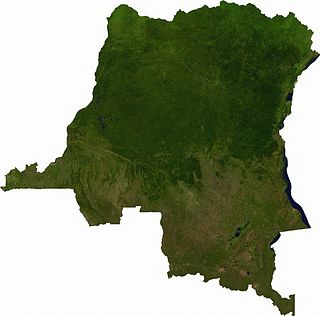
Ground transport in the Democratic Republic of the Congo (DRC) has always been difficult. The terrain and climate of the Congo Basin present serious barriers to road and rail construction, and the distances are enormous across this vast country. Furthermore, chronic economic mismanagement and internal conflict has led to serious under-investment over many years.

The Ilyushin Il-76 is a multi-purpose, fixed-wing, four-engine turbofan strategic airlifter designed by the Soviet Union's Ilyushin design bureau as a commercial freighter in 1967, to replace the Antonov An-12. It was developed to deliver heavy machinery to remote, and poorly served areas. Military versions of the Il-76 have been widely used in Europe, Asia and Africa, including use as an aerial refueling tanker, and command center.

Mbuji-Mayi or Mbujimayi is a city and the capital of Kasai-Oriental Province in the south-central Democratic Republic of Congo. It is thought to be the second largest city in the country, after the capital Kinshasa and ahead of Lubumbashi, Kisangani and Kananga, though its exact population is not known. Estimates range from a 2010 CIA World Factbook estimated population of 1,480,000 to as many as 3,500,000 estimated by the United Nations in 2008.

Hewa Bora Airways Sarl was the national airline of the Democratic Republic of the Congo based in Barumbu, Kinshasa, Democratic Republic of the Congo. It was one of Congo's largest airlines and operated regional and domestic services. Its main base was N'djili Airport. "Hewa bora" is Swahili for "fresh air". The company slogan was N°1 in Democratic Republic of the Congo.
Wimbi Dira Airways was a scheduled and charter, passenger and cargo airline based in Kinshasa, Democratic Republic of the Congo. It serves the country's main cities. As of May 2014 all of their planes were reported to be in storage.
Bravo Air Congo was an airline based in Kinshasa, Democratic Republic of the Congo operating domestic and regional passenger services. Its main base was N'djili Airport.

Ukrainian Cargo Airways was an airline based in Kyiv, Ukraine. It was a state-owned company operating charter passenger and cargo services. It also overhauled, leased and sold aircraft, engines and aviation equipment. Its main bases were Kyiv Boryspil International Airport (KBP) and Zaporizhzhia International Airport (OZH).
Compagnie Africaine d'Aviation, renamed FlyCAA in 2013, is a regional airline from the Democratic Republic of the Congo, based at N'djili Airport in Kinshasa. It offers an extensive network of domestic scheduled passenger flights, as well as cargo flights. Due to safety and security concerns, CAA has been included in the list of air carriers banned in the European Union.

Maya–Maya Airport is the international airport of Brazzaville, the capital of the Republic of Congo.
The Vodacom Ligue 1 is the top division of the Congolese Association Football Federation, the governing body of football in the Democratic Republic of the Congo. It was created in 1958. In 2013, the highest attendance was set in the match DC Motema Pembe – AS Vita Club, which saw an attendance of 80,000 football fans at Stade des Martyrs. TP Mazembe is the most successful club with 20 titles.

Articles related to the Democratic Republic of the Congo include:
The Coupe du Congo is the top knockout tournament of the Congolese football. It was created in 1961.

The 2007 Africa One Antonov An-26 crash occurred when a twin engine Antonov An-26, belonging to the Congolese air carrier Africa One, crashed and burned shortly after takeoff from N'djili Airport in Kinshasa, Democratic Republic of the Congo on 4 October 2007. The flight left N'djili at 10:43 local time bound for Tshikapa, a distance of 650 kilometres to the east.

On 15 April 2008, Hewa Bora Airways Flight 122, a McDonnell Douglas DC-9-51 plane crashed into a residential and market area of Goma of the Democratic Republic of the Congo immediately south of Goma International Airport.
Korongo Airlines sprl was an airline from the Democratic Republic of the Congo, headquartered in Lubumbashi. It was founded on behalf of Brussels Airlines and other Belgian investors in 2009, and operated scheduled regional flights from its base at Lubumbashi International Airport.

On 25 August 2010, a Let L-410 Turbolet passenger aircraft of Filair crashed on approach to Bandundu Airport in the Democratic Republic of the Congo, killing all but one of the 21 people on board.

On 4 April 2011, Georgian Airways Flight 834, a Bombardier CRJ100 passenger jet of Georgian Airways operating a domestic flight from Kisangani to Kinshasa in the Democratic Republic of Congo (DRC) crashed while attempting to land at Kinshasa Airport. The aircraft, which was chartered by the United Nations, was trying to land during a thunderstorm. Of the 33 people on board, only one person survived. The incident remains as the United Nations' deadliest aviation disaster. It is also the third-deadliest air disaster involving the CRJ100/200, behind Comair Flight 5191 and China Eastern Airlines Flight 5210.
Lignes Aériennes Congolaises, also known by its acronym LAC, was an airline of the Democratic Republic of the Congo, with its head office in Kinshasa, and its central administration on the property of N'djili Airport in Kinshasa. The carrier has the latter airport as the base of its flight operations. It was liquidated in 2013.
The University of Mbuji Mayi (UM) is an accredited private university in the Democratic Republic of the Congo, located in the province of Kasai-Oriental, city of Mbuji Mayi. The university is one of the many initiatives by the "Fondation Cardinal Malula". The UM, exists alongside other institutions of higher learning such as the C.U.M. People mostly mix these two different and separate entities. At its creation, the C.U.M was an Extension of national public universities" amongst which the University of Kinshasa, the University of Lubumbashi and the University of Kisangani. Instruction is in French.
Congo Airways S.A. is the state-owned flag carrier airline of the Democratic Republic of the Congo (DRC). With a paid-up capital of US$90 million, it started operations on 20 October 2015.











